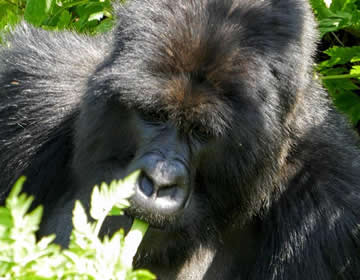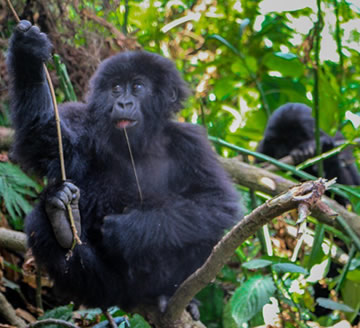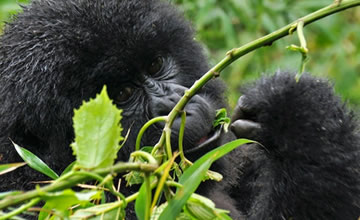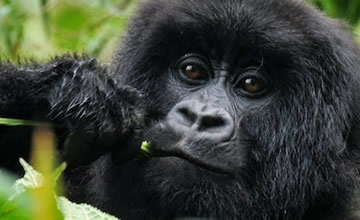Mountain gorillas present very interesting features from their physical appearance, adoption to their habitat, social behaviors with one another, elders, silverbacks and the very way they present as human beings. Gorillas have unique behaviors which make it very interesting observing them in the jungle while visiting to see gorillas.
Gorilla Physical Appearance
The mountain gorillas are large apes with short thick trunk and broad chest and shoulders. Their eyes and ears are dwarfed its huge head and hairless, shiny black muzzle. Mature males grow a crown of muscle and hair which makes the head appear even longer than for any other gorilla species which makes them adaptable in colder temperatures. The hair on the backs is shorter than on most other body areas. The arms are longer compared to the stubby legs. Gorillas can be identified by their nose prints rare from one another. The fully adult male is twice as huge as the female. Adult males have more pronounced bony crests on the top and back of their skulls offering their heads a more conical shape. Males are 1.9 meters in height, with an arm stretch up to 2.3 meters and weight of 220 kilograms. Mountain gorillas are mainly terrestrial and quadrupedal but they can also climb into fruiting trees if the branches can carry their weight and they are in position to run. The young mountain gorillas can play in trees just like children. They move using their knuckle just like the chimpanzees.
Mature males grow a crown of muscle and hair which makes the head appear even longer than for any other gorilla species which makes them adaptable in colder temperatures. The hair on the backs is shorter than on most other body areas. The arms are longer compared to the stubby legs. Gorillas can be identified by their nose prints rare from one another. The fully adult male is twice as huge as the female. Adult males have more pronounced bony crests on the top and back of their skulls offering their heads a more conical shape. Males are 1.9 meters in height, with an arm stretch up to 2.3 meters and weight of 220 kilograms. Mountain gorillas are mainly terrestrial and quadrupedal but they can also climb into fruiting trees if the branches can carry their weight and they are in position to run. The young mountain gorillas can play in trees just like children. They move using their knuckle just like the chimpanzees.
Behavior
Mountain gorillas are diurnal, most active between 6:00am and 6:00pm, with a nap around a launch time. Much of the time is spent feeding as large quantities of food are needed to sustain their large bodies.
They forage in early morning, rests late in the morning and in the midday and also afternoon they eat prior retiring at night.

Every mountain gorilla constructs a nest from surrounding vegetation for sleeping and one new nest is built ever day. Only babies are allowed to share with the mother in same nest.
They leave their nests when the sun rises at 6:00am unless it is cold and overcast then they often remain in their nests for sometime. The male gorilla is about 10 times stronger than humans
The mountain gorillas are shy and retiring rather than ferocious and treacherous.
The gorilla groups can range from 30-40 members with one dominant male who is termed as silverback that will be leading females and some young ones.
They have stronger attachments to members of their own family and even when the family encounters and associates, every member tends remain with its particular unit.
A mature male gorilla is called a silverback that derives its name from the silver gray hair on the back; he heads the family, offers protection and defense.
Mountain gorillas keep wandering via home range from 16.1 kilometers to 24.1 kilometers, while feeding and resting all the day. They scream, garb leaves stuff it their mouths, stand straight, tear up and throw plants, drum on their chests with hands, stamp their feet, strike the ground with the palms of their hands and gallop in a mock attack in all fours.
Whereas they are powerful, they can be habituated meaning, they can get used to human presence and the habituation lasts for about 2 years for them to get accustomed to human presence.
They have 25 different sounds and mainly used for communication within the forest. The sounds are classified as grunts and barks.

They are largely vegetarians, depending on a number of plants (142 species) mainly on the wild celery, bamboo, thistles, stinging nettles, bedstraw and some fruits. These plant species offer sufficient moisture and gorillas have no need for water again. They live within altitude 2200 to 4300 meters in thick forest. A grown up male eats up to 34 kilograms of vegetation per day while female eats 18 kilograms.
Reproduction
These great apes have a slow rate of reproduction; females produce for the first time at around 10 years and will the get young one after each 3 or 4 years. The male starts to breed between 12 and 15 years when he is in control of his own family. A female is position to conceive for only 3 days every month, producing one baby at a time though they also give birth to twins. The newly born gorillas are weak and small in size, weighing about four pound. At three or four months, they can sit upright and even stand with support. Babies suckle for a year and gradually weaned at 3 and half years when it can live alone. Females become sexually mature at 7 to 8 years but do not begin to breed till after many years and they have a long gestation period of 8 and half to nine months. The mortality rate for gorillas is less than one year but for adults the rate is only 5 percent. In the natural environment they can survive up to 40 to 50 years.
Threats
Unlike other wildlife, the rare mountain gorillas are highly threatened species especially due to habitat loss. Much of the volcanic soils have been put under agriculture making the lives of these endangered species at a risk of extinction. In Uganda, Rwanda and the DR Congo, regional conservation program stressing the value of keeping the virgin forest watershed and the need to habituate some groups for tourist visits has helped ease encroachment.

The mountain gorilla’s main threats include leopards, humans and crocodiles. They are hunted for meat or at times retaliation for crop destruction in the community or they become victims of wire snares and traps that are set for antelopes and other small animals. They share about 95 percent of their DNA with humans meaning they are highly susceptible to human diseases. And this is why visitors are advised to keep a distance of about 7-8 meters from the ape while in the forest.
In conclusion, mountain gorillas are exceptionally the rarest wildlife species in the world. An encounter with them in their natural environment is such a dramatic and magical experience that comes once in a lifetime.

